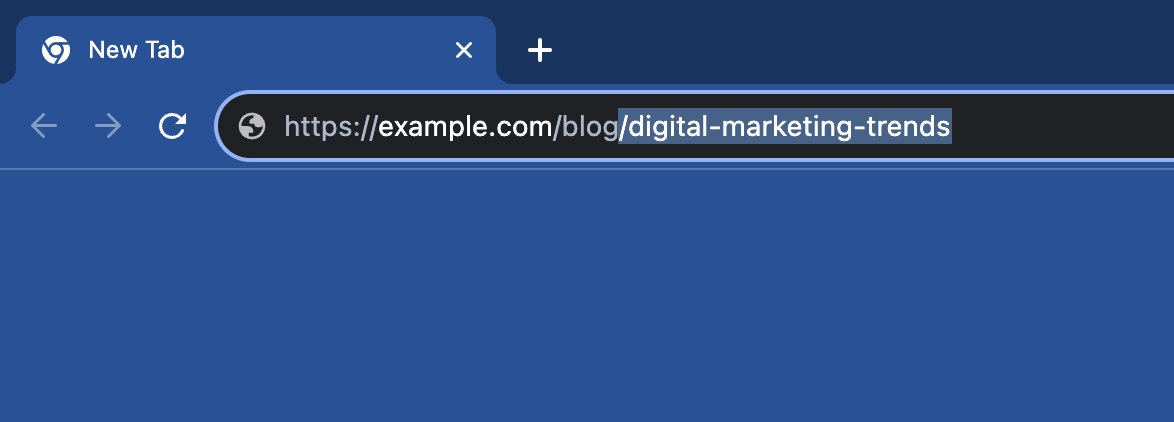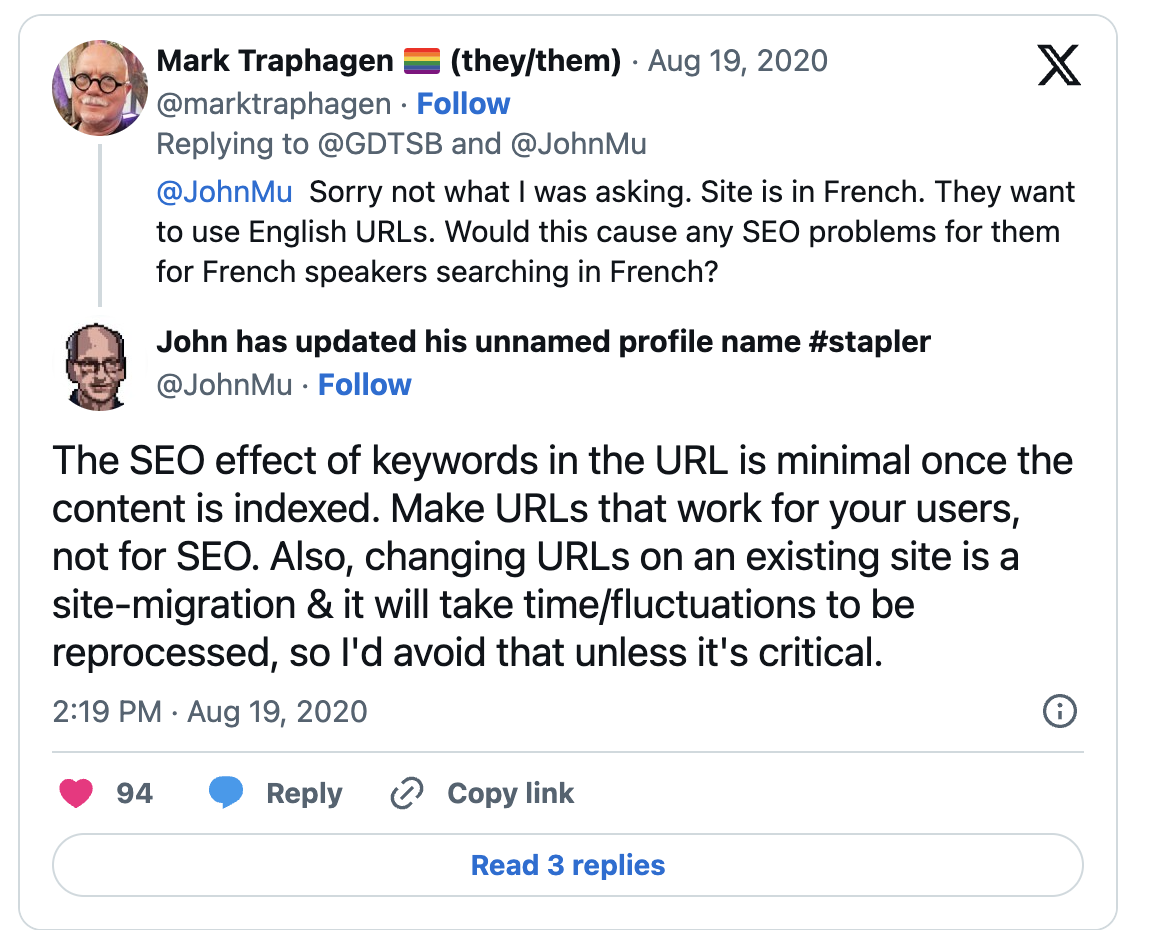URL Slug
Deciding on a URL slug is like giving your webpage a name. It’s the name internet users use to identify and find your content. Here’s how to choose the right slug for your content:
What Is a URL Slug?
A URL slug is a part of a web address that tells you what the page is about. Imagine looking at a link in your browser. That whole link is the URL. Inside that URL, the slug is a short, easy-to-understand piece that gives you a hint about the page’s content.
Let’s consider the example of a web address like:
https://example.com/blog/digital-marketing-trends
In this case, “digital-marketing-trends” is referred to as the slug. The slug isn’t just a random combination of words; it serves as an indication of what the content is about. This makes it crucial to make the slug descriptive and relevant.

The Importance of the URL Slug in SEO
While you might be tempted to think that a URL slug is just a part of the web address, it plays a more significant role than you might imagine. Google Search Advocate, John Mueller, shed some light on this by confirming that words in a URL do impact rankings.
A URL slug doesn’t just guide human users—it plays a pivotal role for search engines too. When constructing a webpage, every element counts and the URL slug is no exception. It might appear like a minor detail, but its SEO implications are vast. Here’s an in-depth examination of its importance:

How to Choose the Right URL Slug?
Deciding on a URL slug is like giving your webpage a name. It's the name internet users use to identify and find your content. Here's how to choose the right slug for your content:
- Understand Your Content: Before you decide on a slug, understand the essence of your content. What's the main topic? What's the primary keyword?
- Keep It Relevant: The slug should be relevant to the content of the page. If your article is about homemade pizza recipes, a slug like "/delicious-homemade-pizza" would be appropriate.
- Avoid Using Stop Words: Words like "and", "the", "of", and "in" are considered stop words in SEO. These are typically ignored by search engines and can be left out of your slug to keep it shorter and more readable.
- Avoid Duplicates: Ensure that your slug is unique. Having two pages with the same slug can lead to confusion for both search engines and users.
- Think About Your Audience: Remember, while search engines are important, humans will be reading your URLs too. Think about what they would like to see and what would make sense to them.
- Stay Consistent: If you have a series of related articles, try to keep the slug structure consistent. For example, if you're writing a series of travel guides, you could use slugs like "/travel-guide-paris", "/travel-guide-rome", etc.
Best Practices When Crafting a URL Slug
Try to Be Descriptive:
The purpose of a URL slug is to convey the page's content swiftly and succinctly.
Example:
✅ /top-laptops-2023
❌ /item3456
Incorporating the primary keyword, which encapsulates the gist of the page, is a proven strategy.
Keep It Short and Sweet:
Overly elongated slugs might deter users and often don't display fully in search results.
Example:
✅ /vegan-recipes
❌ /ultimate-guide-to-vegan-recipes-for-beginners
Separate Words Clearly:
Distinctly separated words in a slug enhance its clarity and accessibility.
Example:
✅ /home-cleaning-tips
❌ /homecleaninghints
Use Hyphens Over Other Separators:
Hyphens are the gold standard for word separation in slugs, as they're most universally recognized by search
engines.
Example:
✅ /chocolate-chip-cookies
❌ /chocolate_chip_cookies
Stick to Lowercase:
Consistency is key. Use lowercase letters to prevent potential URL errors and confusion.
Example:
✅ /paris-travel-guide
❌ /Paris-Travel-Guide
Avoid Peculiar Characters:
Steer clear from characters that aren't universally understood or can lead to errors.
Example:
✅ /sign-language
❌ /sign✋language
Ensure It’s Timeless:
Avoid transient details like the current year or counts that might change. Remember: If you change the URL
slug, always set up a redirect from the previous URL to the updated one.
Example:
✅ /seo-strategies
❌ /12-seo-strategies-2023
In Conclusion: The Power of a Good URL Slug
URL slugs do more than just point visitors to the right page on your site. They serve as a direct line of communication, providing a preview of the content that awaits readers. However, their significance extends beyond this initial introduction. Search engines greatly value URL slugs as they assist in effectively categorizing, ranking, and displaying your content.
By investing time in crafting clear and descriptive slugs, and integrating them into a solid URL strategy, you’re setting your site up for better SEO success. Don’t overlook them; these small segments in your URLs can make a big difference.
FAQs on URL Slug
While there isn't a strict maximum length for a URL slug, it's advisable to keep it under 45 characters for readability. Search engines can handle much longer URLs, but a concise slug is user-friendly and more likely to be remembered.
When you alter a URL slug, you're essentially changing the web address of that specific page. This can lead to broken links—any previous links directed towards that page will hit a dead end, showing the dreaded 404 error. But, fret not! This mishap can be avoided by setting up a redirect and guiding users from the old URL directly to the new one.
A URL slug is the portion of a web address that follows the domain name and describes the page's content. For example, in https://example.com/blog/tasty-pizza-recipes, "tasty-pizza-recipes" serves as the slug.
Not quite! The URL is the entire web address you see in your browser, like https://example.com/blog/tasty-pizza-recipes. On the other hand, the slug is just a segment of this address, specifically tasty-pizza-recipes in our example.
The term "slug" originates from the world of print journalism. In the days of manual typesetting, a slug referred to a piece of type metal cast as a single line of characters. In the digital realm, it's been borrowed to describe a string of words forming a simple, clean URL segment.
Yes, indeed! The slug is a portion of the URL. When you modify the slug, you are altering that part of the URL. Hence, the entire web address of the page changes.
